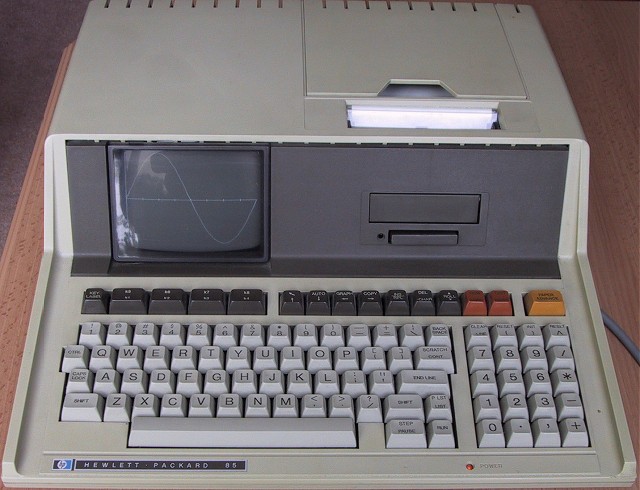hp 85
| check this out! the hp-85 microcomputer introduced january 1980. original cost $3250. initially aimed at the engineering market, this model was both a calculator and a microcomputer. using a custom 8 bit microprocessor derived from the calculator world, it calculates in bcd (ie decimal) like a true calculator but is programmable in basic like a microcomputer. closer to a calculator too its its numeric precision, a 12 digit (decimal) mantissa with exponents up to +/-499 and a full set of scientific functions at this accuracy. other basic implementations available at the time were lacking, most supporting single precision floating point (about 6 digits) and lacking scientific functions (arcsine and arccosine were usually missing). |
 |
what is cool about this machine is that its capabilities are integrated into one unit. the screen is a 5" monochrome crt with 16 scrollable lines of 32 characters. the thermal printer works well and the tape drive provides off line storage of programs onto dc-100 cartridges and the convenient means to load up programs from the many application libraries. all this, and a very well constructed case and quality keyboard, make the machine highly usable. even today, it can impress in certain respects.
the implementation of basic is very good and has many worthwhile enhancements. as well as the aforementioned numerical capabilities, the language has a lot of useful stuff; on...goto print using, versatile string manipulation, arrays, function definitions, a timer and the ability to beep with different tones and durations. the display acts like a screen editor where you can move the cursor over anything, like a line of program, and edit it. this feature avoids much pointless re-typing. the display can also be scrolled back so that 48 lines history are preserved.advanced for the time, is the ability to use the screen as a pixel addressed graphic display. particularly impressive is the built-in commands to assist plotting, drawing lines, scaling and graphical axes. indeed, by providing a scale and origin, there is no need to plot in terms of the raw pixel coordinates. your program can work in its relevant domain. graphical x & y axes use this too and the xaxis and yaxis commands work superbly. the graphical screen can be copied to the printer as required and this is great for hardcopy graphs and stats which are printed sideways in order to take advantage of the paper dimensions.
the base unit has 16k of ram and a 32k rom. there are 4 expansion ports on the back that can accommodate more memory (another 16k for this model) and a multitude of optional peripherals like rs232, disk controllers, a modem and additional roms.
the built-in features are efficient, but the overall execution speed of programs is quite slow. the processor is only 8 bit and runs at 625kHz which is lacking even for 80's (the trs-80 ran a Z80 at 1.77MHz and the apple2 a 6502 at 1Mhz).
unless it has been refurbished, units of this age will have problems with the tape drive because the rubber pinch wheel inside the tape drive perishes leading to the so-called gummy wheel problem.